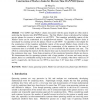Free Online Productivity Tools
i2Speak
i2Symbol
i2OCR
iTex2Img
iWeb2Print
iWeb2Shot
i2Type
iPdf2Split
iPdf2Merge
i2Bopomofo
i2Arabic
i2Style
i2Image
i2PDF
iLatex2Rtf
Sci2ools
PE
2015
Springer
2015
Springer
Construction of Markov chains for discrete time MAP/PH/K queues
Two GI/M/1 type Markov chains associated with the queue length are often used in analyzing the discrete time MAP/PH/K queue. The first Markov chain is introduced by tracking service phases for servers; a method we call TPFS. The transition probability matrix of the Markov chain can be constructed in a straightforward manner. The second Markov chain is introduced by counting servers for phases; which we call CSFP. An algorithm is developed for the construction of the transition probability matrix of the second Markov chain, which is the main contribution of this paper. Whereas the construction of the matrices for the case of continuous time is available in the literature, it is not available for the discrete time case. The effort in constructing the matrices for the discrete time case is extensively more involved than for the continuous time case. Some basic properties of the constructed transition blocks are shown. We demonstrate that for queueing systems with a large number of servers...
Optimization | PE 2015 |
| Added | 16 Apr 2016 |
| Updated | 16 Apr 2016 |
| Type | Journal |
| Year | 2015 |
| Where | PE |
| Authors | Qi-Ming He, Attahiru Sule Alfa |
Comments (0)

